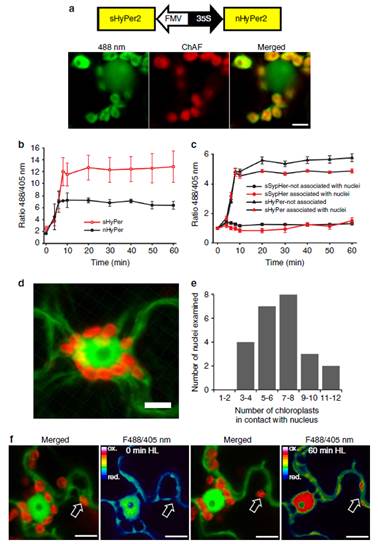过氧化氢保护植物免受太阳伤害

过氧化氢 (H2O2) 常被用于漂白和头发护理,而新研究表明,植物却借此控制细胞对不同强度阳光的反应方式。
该化学物是植物叶绿体光合作用的副产物。
过氧化氢的信号作用曾经也被怀疑过,但这一由埃克塞特大学和埃塞克斯大学研究者进行的研究首先发现了这是如何和在何处发生的。
埃克塞特大学教授 Nick Smirnoff 说道:“检测有多少阳光对于植物至关重要,这样他们才能最大程度地进行光合作用。”
“他们也需要进行调整以保护自己,因为高强度的阳光会损害叶片,类似于我们人类的皮肤被晒伤。”
埃塞克斯大学教授 Phil Mullineaux 说道:“我们知道很多不同信号会被发送到细胞核来切换基因和重新组织细胞的工作方式,但这是首次发现这些信号从光合作用发生的叶绿体中向细胞核移动。”
这一研究受到英国生物技术和生物科学研究委员会的赞助。
通过利用荧光蛋白检测过氧化氢,研究者观察了过氧化氢如何从叶绿体开始移动并在细胞核中被检测到的。
植物基因位于细胞核,新发现的这一过程显示了植物如何激活叶片适应明亮阳光可能产生的伤害作用所需的基因。这个叶绿体与细胞核的交流过程确保了植物继续进行光合作用并适应环境。农作物的光合作用决定了长势和产出。
科学家还发现某些产生过氧化氢信号的叶绿体附着在细胞核上,从而能高效地传递这一化学物。
第一作者、前埃克塞特大学学生、现埃塞克斯大学博士 Marino Exposito-Rodriguez 说道:“过氧化氢荧光蛋白传感器的研发使得这一突破成为可能,使我们能实时观察到过氧化氢在植物细胞中的移动。”(来源:生物360)
Photosynthesis-dependent H2O2 transfer from chloroplasts to nuclei provides a high-light signalling mechanism
Chloroplasts communicate information by signalling to nuclei during acclimation to fluctuating light. Several potential operating signals originating from chloroplasts have been proposed, but none have been shown to move to nuclei to modulate gene expression. One proposed signal is hydrogen peroxide (H2O2) produced by chloroplasts in a light-dependent manner. Using HyPer2, a genetically encoded fluorescent H2O2 sensor, we show that in photosynthetic Nicotiana benthamiana epidermal cells, exposure to high light increases H2O2 production in chloroplast stroma, cytosol and nuclei. Critically, over-expression of stromal ascorbate peroxidase (H2O2 scavenger) or treatment with DCMU (photosynthesis inhibitor) attenuates nuclear H2O2 accumulation and high light-responsive gene expression. Cytosolic ascorbate peroxidase over-expression has little effect on nuclear H2O2 accumulation and high light-responsive gene expression. This is because the H2O2 derives from a sub-population of chloroplasts closely associated with nuclei. Therefore, direct H2O2 transfer from chloroplasts to nuclei, avoiding the cytosol, enables photosynthetic control over gene expression.
原文链接:http://repository.essex.ac.uk/19933/1/s41467-017-00074-w.pdf

